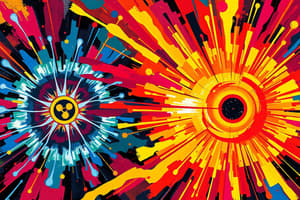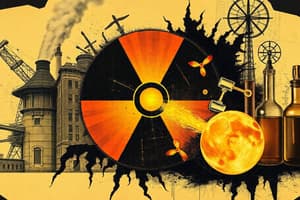Podcast
Questions and Answers
What happens to the elements involved in a nuclear reaction?
What happens to the elements involved in a nuclear reaction?
- They are destroyed.
- They typically change. (correct)
- They remain unchanged.
- They transform into different isotopes.
Which of the following is NOT a feature of nuclear fission?
Which of the following is NOT a feature of nuclear fission?
- Fission requires a catalyst. (correct)
- Fission products are radioactive.
- Excess neutrons are released.
- Chain reactions can occur.
What does thermal neutrons refer to in the context of nuclear fission?
What does thermal neutrons refer to in the context of nuclear fission?
- Neutrons that are moderated to lower speeds. (correct)
- Neutrons that cause spontaneous fission.
- Neutrons that are too fast to be absorbed.
- Neutrons that are produced by fission.
What is a significant outcome of a chain reaction in nuclear fission?
What is a significant outcome of a chain reaction in nuclear fission?
Which type of radiation is released during nuclear fission along with neutrons?
Which type of radiation is released during nuclear fission along with neutrons?
How does the speed of neutrons affect nuclear fission reactions?
How does the speed of neutrons affect nuclear fission reactions?
What is the result of bombarding a uranium-235 nucleus with a neutron?
What is the result of bombarding a uranium-235 nucleus with a neutron?
What happens after uranium-236 undergoes fission?
What happens after uranium-236 undergoes fission?
What is one reason nuclear fusion is not currently used for power generation?
What is one reason nuclear fusion is not currently used for power generation?
What is a characteristic of nuclear fusion?
What is a characteristic of nuclear fusion?
Which of the following best defines binding energy in nuclear reactions?
Which of the following best defines binding energy in nuclear reactions?
What type of reaction is represented by the equation 1H + 1H → 1H + 0n + energy?
What type of reaction is represented by the equation 1H + 1H → 1H + 0n + energy?
Which aspect of fission differs most from fusion?
Which aspect of fission differs most from fusion?
What factor contributes to the mass defect in nuclear reactions?
What factor contributes to the mass defect in nuclear reactions?
Which of the following advantages does nuclear fusion have over nuclear fission?
Which of the following advantages does nuclear fusion have over nuclear fission?
Which material is NOT typically used as a moderator in nuclear reactions?
Which material is NOT typically used as a moderator in nuclear reactions?
In a nuclear fission reaction, what is the primary purpose of absorbing excess neutrons using boron rods?
In a nuclear fission reaction, what is the primary purpose of absorbing excess neutrons using boron rods?
Which statement accurately reflects the nature of nuclear reactions compared to chemical reactions?
Which statement accurately reflects the nature of nuclear reactions compared to chemical reactions?
What is a critical characteristic of fission products in nuclear reactions?
What is a critical characteristic of fission products in nuclear reactions?
What outcome is most likely when uranium-235 absorbs a neutron?
What outcome is most likely when uranium-235 absorbs a neutron?
Which scenario describes the necessary conditions for a chain reaction in nuclear fission?
Which scenario describes the necessary conditions for a chain reaction in nuclear fission?
Which condition must be met for neutrons to effectively induce fission?
Which condition must be met for neutrons to effectively induce fission?
In nuclear fusion reactions, what role does energy play?
In nuclear fusion reactions, what role does energy play?
What is one significant difference between the processes of fission and fusion?
What is one significant difference between the processes of fission and fusion?
Which type of radiation is commonly emitted during a nuclear fission reaction?
Which type of radiation is commonly emitted during a nuclear fission reaction?
Flashcards
Nuclear vs. Chemical Reactions
Nuclear vs. Chemical Reactions
Nuclear reactions change elements and release large energy.
Types of Nuclear Reactions
Types of Nuclear Reactions
There are two main types: Fission and Fusion.
Nuclear Fission
Nuclear Fission
The splitting of a large nucleus into smaller nuclei with energy release.
Spontaneous Fission
Spontaneous Fission
Signup and view all the flashcards
Induced Fission
Induced Fission
Signup and view all the flashcards
Chain Reaction
Chain Reaction
Signup and view all the flashcards
Thermal Neutrons
Thermal Neutrons
Signup and view all the flashcards
Fission Products
Fission Products
Signup and view all the flashcards
Boron Rods
Boron Rods
Signup and view all the flashcards
Moderators
Moderators
Signup and view all the flashcards
Features of Nuclear Fusion
Features of Nuclear Fusion
Signup and view all the flashcards
Binding Energy
Binding Energy
Signup and view all the flashcards
Mass Defect
Mass Defect
Signup and view all the flashcards
Energy from Fusion vs. Fission
Energy from Fusion vs. Fission
Signup and view all the flashcards
Coulomb’s Repulsive Force
Coulomb’s Repulsive Force
Signup and view all the flashcards
Radioactive Fission Products
Radioactive Fission Products
Signup and view all the flashcards
Self-Sustaining Reaction
Self-Sustaining Reaction
Signup and view all the flashcards
Importance of Neutron Speed
Importance of Neutron Speed
Signup and view all the flashcards
Nuclear Reaction Rates
Nuclear Reaction Rates
Signup and view all the flashcards
Fission Induction
Fission Induction
Signup and view all the flashcards
Chain Reaction Conditions
Chain Reaction Conditions
Signup and view all the flashcards
Fusion Reaction
Fusion Reaction
Signup and view all the flashcards
Advantages of Fusion
Advantages of Fusion
Signup and view all the flashcards
High Temperature Required
High Temperature Required
Signup and view all the flashcards
Binding Energy and Mass Defect
Binding Energy and Mass Defect
Signup and view all the flashcards
Energy from Fusion
Energy from Fusion
Signup and view all the flashcards
Fusion vs Fission Waste
Fusion vs Fission Waste
Signup and view all the flashcards
Temperature in Fusion
Temperature in Fusion
Signup and view all the flashcards
Study Notes
Week Eleven: Lesson Three - Energy Changes in Nuclear Reactions
- Nuclear reactions differ significantly from chemical reactions.
- Elements change during nuclear reactions, while electrons change less frequently in nuclear reactions.
- Nuclear reactions release substantial energy, causing mass changes.
- Reaction rates aren't affected by temperature or catalysts.
Lesson Objectives
- Differentiate between nuclear and chemical reactions.
- Understand various types of nuclear reactions.
- Calculate mass defect and binding energy.
Nuclear Reactions: Types
- Nuclear Fission: Large nuclei split into smaller, nearly equal parts, releasing energy. Spontaneous fission is rare; induced fission is more common. Typically, heavy nuclei are bombarded with neutrons.
- Example: U-235 absorbing a neutron to form unstable U-236, which rapidly fissions into smaller nuclei (e.g., xenon-140 and strontium-93) and releasing neutrons and energy (gamma radiation, too.)
- Nuclear Fusion: Light nuclei fuse into a heavier nucleus, releasing energy. An example is the fusion of hydrogen isotopes in the Sun and stars. Occurs at extremely high temperatures, necessary to overcome repulsion forces between positively charged nuclei.
Features of Nuclear Fission
- Fission products are radioactive.
- Excess neutrons are released.
- Neutrons can induce further fissions, creating a chain reaction.
Nuclear Fusion Features
- Mostly in the sun.
- Occurs at extremely high temperatures.
- Products are not radioactive.
- No material can withstand the temperatures needed to create sustained fusion and maintain it.
- Energy released is significantly greater than in fission.
Advantages of Fusion over Fission
- Easier to achieve (lesser repulsion between light nuclei)
- Easily accessible fuel (hydrogen isotopes).
- Less dangerous, due to less radioactive products.
- No chain reaction concerns.
Binding Energy
-
Binding energy is the energy required to bring nucleons (protons and neutrons) together or to separate them.
-
Binding energy is equivalent to the mass defect.
-
Mass defect is the difference in mass between the sum of the separated nucleons and the resultant nucleus.
-
Binding energy is from the forces holding the nucleus.
-
Binding energy is calculated using E=mc². A mass difference results in energy release.
-
Different nuclei have differing binding energies. In fission, large nucleus splits into smaller parts; the lower total mass of smaller nuclei after fission results in energy released.
-
Fast neutrons must be slowed down (moderators such as graphite rods) for fission to happen. Excess neutrons are absorbed using boron rods.
Studying That Suits You
Use AI to generate personalized quizzes and flashcards to suit your learning preferences.




